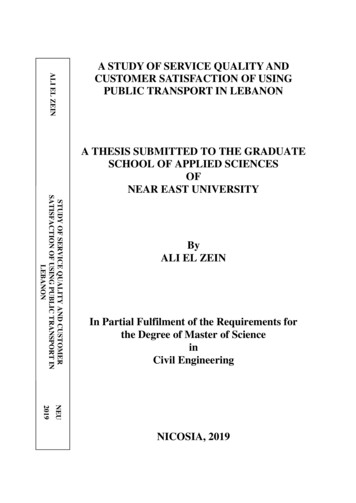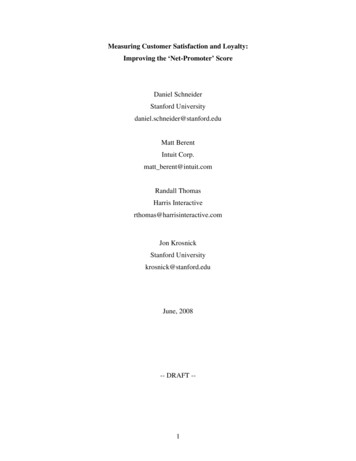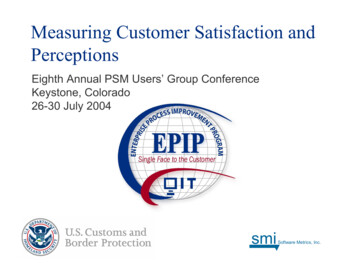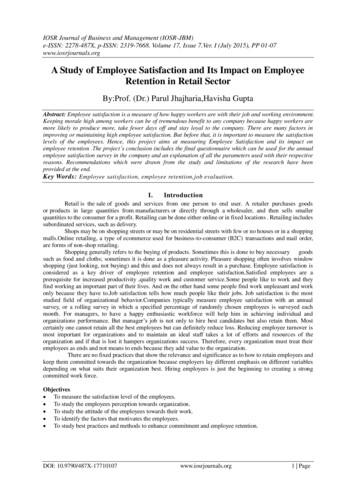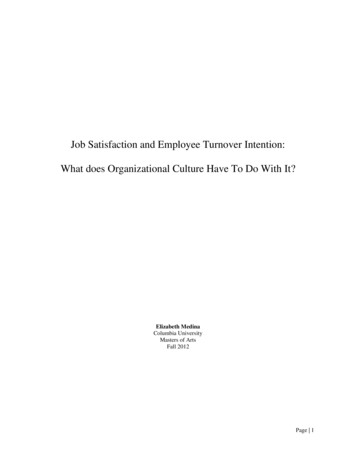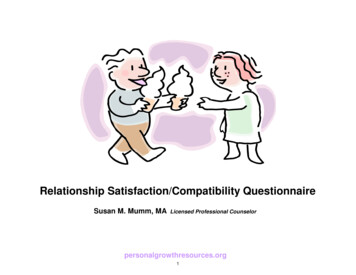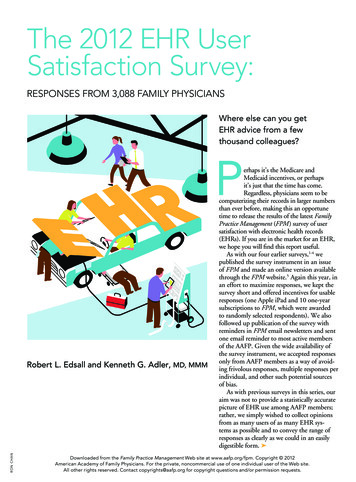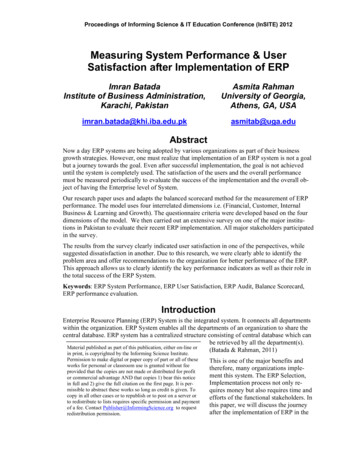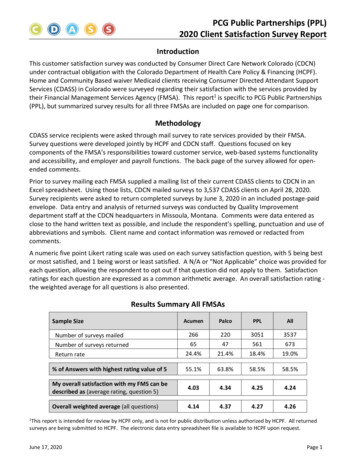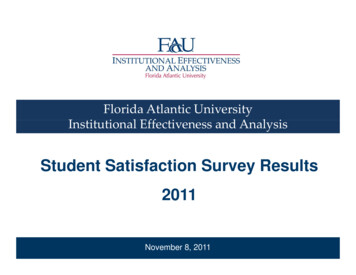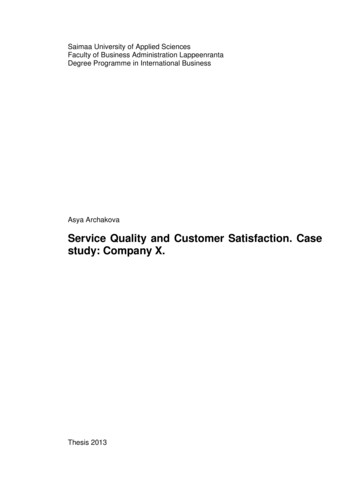
Transcription
Saimaa University of Applied SciencesFaculty of Business Administration LappeenrantaDegree Programme in International BusinessAsya ArchakovaService Quality and Customer Satisfaction. Casestudy: Company X.Thesis 2013
AbstractAsya ArchakovaService Quality and Customer Satisfaction. Case study :Company X, 39 pages,1 appendixSaimaa University of Applied SciencesFaculty of Business Administration, LappeenrantaDegree Programme in International BusinessThesis 2013Instructors: principal lecturer Minna Ikävalko, Saimaa University of Applied Sciences, managing director Dita Kaarna, Company X.Customer satisfaction and service quality are one of the basic opportunitieswhich help to run, to improve business and profit of the company, and especially save the loyalty of its customers. Good service is a result of organized corporate culture, which can be considered as a kind of social culture in general. Setting the values of a generalized trend of activity, rules, regulations and standards concretize this direction. In theory parts are described five determinants ofgood service quality and customer perception of service measuring. The intension of the research study was to find out what customers think about company’s service quality and if customer satisfaction level is good enough to attractmore consumers and save those who have been loyal to the company foryears.Data for this study were collected in Company X, which is situated in EteläKarjala region, mostly suitable for Russian tourists. The questionnaires werehanded out in the market during the shopping process or sent via e-mail. Theresearch was set to examine the customer’s satisfaction level with the serviceprovided by the company.This study will help the company to improve its service quality for better customer satisfaction. It may be a good example of what can be improved not onlyfor the Company X, but also for the companies which are fully or partly targetedon Russian customers.Keywords: Customer Satisfaction, Service Quality, Organisation standards2
Table of Contents1Introduction . 41.1 Background of the study . 41.2 Objectives and Delimitations. 51.3 Structure of the research . 52 Corporate culture and Organization standards . 62.1 Service Quality . 82.2 Service Quality Determinants and the SERVQUAL Instrument . 82.3 Service Gaps . 102.4 Finding Service Quality Attributes and Measuring Quality Perceptions113 Customer Satisfaction . 143.1 Definition of Customer Satisfaction . 143.2 Importance of Customer satisfaction . 164 Customer Satisfaction Measurement . 174.1 Definition of Customer Satisfaction Measurement . 174.2 Advantages of Customer Satisfaction Measurement Programs . 195 Empirical Research . 205.1 Introduction to the Case Company X . 205.2 Research Methodology . 205.3 Customer Satisfaction Direct Measurement and Research process . 205.4 Sampling Strategy . 225.5 Validity and Reliability . 226 Data Analysis . 246.1 Number of respondents . 246.2 Age Bracket . 256.3 Service Quality . 256.4 Check-out procedure . 266.5 Invoice and Tax free information . 276.6 Service expectations in occurred issues related to the returned ordamaged goods and rejected Invoice receipts . 286.7 Product Quality . 296.8 Image of the service quality . 306.9 Image of the Company. 316.10Product assortment in the Market . 326.11Loyalty . 337 Conclusion . 377.1 Summary of the Findings . 377.2 Discussions and Recommendations . 37Figures . 41Charts . 41Tables . 41List of References . 39Appendix . 423
1 IntroductionCustomer Satisfaction and Service Quality are leading components in the system of external relations of each organization, as today they largely determineits competitiveness. The desire to manage relationships with customers leads tothe fact that organizations are starting to pay attention to the development andimplementation of service standards. Reviewing standards of customer serviceas part of the corporate culture of the organization allows finding more effectiveapproaches to its development and implementation.1.1Background of the studyThis study was decided to be carried out after one year of the author’s workingexperience in Company X. As the growing interest of the company’s productionamong Russian customers is very intensive, the idea to make service quality ofcustomer satisfaction research, based on the customer’s point of view, was alogical conclusion for the final thesis.Other reasons for making the survey are also very important: No previous research has been made in this area of studies in the company Intensively growing demand among customers Personal wide work experience in service departmentCustomers do not buy goods or services, they buy the benefits goods and services provided them with. They buy offerings consisting of goods, services, information personal attention and other components. Customers are lifeblood ofany organization, and without them, a firm has no revenues, no profits, andtherefore no market value (Grönroos 2000, 3).To satisfy its customers, the company should listen and accept their feedbackand improve service and goods if it needed to be so.4
1.2Objectives and DelimitationsThe objective of the research is to find out if Company X in Etelä-Karjala regionoffers good service quality, what is the level of customer satisfaction measurements and how it can be improved, including the general atmosphere in themarket.The company has such a big amount of customers that it became an importantissue to evaluate the company’s service, as no customer satisfaction surveyhas been conducted before. Therefore, the research question is: how peoplesee the service quality of the company from the customer’s point of view?The research is restricted to the customers of the Company X in Etelä-Karjalaarea.1.3Structure of the researchThe thesis consists of two parts. The theoretical study part is based on the theory of service quality, service quality determinants, SERVQUAL instrument, service gaps, service quality attributes, quality perception measurements, Sevencriteria of good perceived service quality, customer satisfaction , definition ofcustomer satisfaction, Importance of customer satisfaction, customer satisfaction measurement, corporate culture and organizational standards.After analyzing the resources which were suitable for the research, it was noteasy to decide what is important to mention in the theoretical part of the workand what should be left outside. Cultural and business differences, consequences and causes of customer satisfaction: involving employees and customers, benefits of customer satisfaction – these concepts were reviewed aspossible parts which could be included in theory, but after analyzing them onemore time it was decided that it was not necessary to leave them in the research, because other parts explain the core idea even more detailed.The empirical studies and the service quality of customer satisfaction survey arebased on qualitative research method. It includes research design and an evaluation of the answers, which were given as questionnaires, handed out to thecustomers of the Company X.5
2 Corporate culture and Organization standardsCorporate culture of each organization can be considered as a kind of socialculture in general, so the core of the corporate culture supports a certain systemof values. The latest determine the representation of the standards (rules,standards, and other elements), which should be followed in the organization,and these ideas get their implementation in employee’s behavior. At the moment, there are many definitions of organizational and corporate culture, mostof which come down to understanding the culture of the organization as a system of different elements (rules, regulations, standards, myths, legends, andpatterns of behavior, communication patterns, etc.), and values are the basis ofit. (Ronzina 2010.)Setting the values of a generalized trend of activity, rules, regulations andstandards concretize this direction. Service quality is that component in thestructure of the corporate culture, which, on the one hand is a manifestation ofvalues prevailing in the organization, and on the other hand, defines the specificparameters of behavior. (Ronzina 2010.)Organization may benefit maintenance "spontaneously" or to develop and implement certain requirements to customer service. In organization where theservice is in accordance with the standards, there will be a certain manner ofservice, the specific approach to the client, specific rules and manner of behavior in different situations - concept of behavior in relation to the client. (Ronzina2010.)Considering the behavior of the parameters in organization, they can be standardized in order to quality customer service (Ronzina 2010): Speech formulas, the language (vocabulary) Facial expressions, gestures Proxemics (what position, how to communicate with the buyer) Clothes Makeup, jewelry State of the environment (must be clean)6
Speed of service and response times Security in the buying process OtherService quality must be determined by certain external and internal factors oflife of the organization. The more consciously the specific content of these factors are, the more subtle they are considered in the development of the ServiceQuality, the greater is the probability that it will be effective. These factors are(Ronzina 2010): Norms of human rights (the law of consumer protection, etc.) Cultural norms that exist in a society in which the organization offers itsproducts and / or services in the market The values and mission of the organization Characteristics of the goods and services offered by the organization Characteristics of target groups (clients) Features of the premises where customers are served (close, spacious,quiet, noisy, etc.) Other factorsCustomer Satisfaction and Service Quality depend a lot on Organization Standards (OS) of the company where they are applied. Latest might work as a greatbenefit to improve the profit and customer loyalty (Ronzina 2010).The following table shows the functions of OS between three communitygroups: employers /customers/employees.EmployersCustomersEmployeesOS help attract and win customersThe presence of OS OS help to make theirthrough competitive service, and as a is a guarantee of SQ working process moreconsequence - to increase profitsof organizationefficiently and to find effective behaviors in theworkplace more easyOS help to ensure the credibility of the OS affects to the7OS affects to the better
organization, long-lasting customermore enjoyable buy- profitloyaltying process and other services in theorganizationOS may help to position the organiza- OS reinforce senseOS contributes self-tion in the market, to create the image, of self-esteem fromdevelopmentreputation, its face, a different atmos- the customer’s sidephere, specificity, uniquenessOS help to manage staff and help it to The presence of OS OS mainly work for thework more efficientlyfacilitate the ongoing cohesion of the group (ifprocess of choosing considering that employbetween the various ees are openly share thisorganizationspoint of view)Table 1: Functions of OS between three community groupsThis
tion measurement, corporate culture and organizational standards. After analyzing the resources which were suitable for the research, it was not easy to decide what is important to mention in the theoretical part of the work and what should be left outside. Cultural and business differences, conse- quences and causes of customer satisfaction: involving employees and cus-tomers, benefits of .
